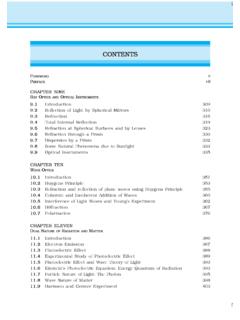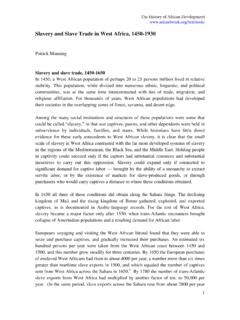Transcription of TRIBES, NOMADS AND SETTLED COMMUNITIES
1 7 tribes , NOMADS AND. SETTLED COMMUNITIES . Y ou saw in Chapters 2, 3 and 4 how kingdoms rose and fell. Even as this was happening, new arts, crafts and production activities flourished in towns and villages. Over the centuries important Fig. 1. political, social and economic developments had Tribal dance, Santal painted scroll. taken place. But social change was not the same everywhere, because different kinds of societies evolved differently. It is important to understand how, and why, this happened. In large parts of the subcontinent, society was already divided according to the rules of varna.
2 These rules, as prescribed by the Brahmanas, were accepted by the rulers of large kingdoms. The difference between the high and low, and between the rich and poor, increased. Under the Delhi Sultans and the Mughals, this hierarchy between social classes grew further. Beyond Big Cities: Tribal Societies There were, however, other kinds of societies as well. Many societies in the subcontinent did not follow the social rules and rituals prescribed by the Brahmanas. Nor were they divided into numerous unequal classes.
3 Such societies are often called tribes . tribes , NOMADS AND. 91 SETTLED COMMUNITIES . Members of each tribe were united by kinship bonds. Many tribes obtained their livelihood from agriculture. Others were hunter-gatherers or herders. Most often they combined these activities to make full use of the natural resources of the area in which they lived. Some tribes were nomadic and moved from one place to another. A tribal group controlled land and pastures jointly, and divided these amongst households according to its own rules.
4 ? Many large tribes thrived in different parts of the On a physical subcontinent. They usually lived in forests, hills, map of the deserts and places difficult to reach. Sometimes they subcontinent, clashed with the more powerful caste-based societies. identify the areas in which tribal In various ways, the tribes retained their freedom and people may have preserved their separate culture. lived. But the caste-based and tribal societies also depended on each other for their diverse needs. This relationship, of conflict and dependence, gradually caused both societies to change.
5 Who were Tribal People? Contemporary historians and travellers give very scanty information about tribes . A few exceptions apart, tribal people did not keep written records. But they preserved rich customs and oral traditions. These were passed down to each new generation. Present- day historians have started using such oral traditions to write tribal histories. Tribal people were found in almost every region of the subcontinent. The area and influence of a tribe varied at different points of time. Some powerful tribes controlled large territories.
6 In Punjab, the Khokhar tribe was very influential during the thirteenth and fourteenth centuries. Later, the Gakkhars became more important. Their chief, Kamal Khan Gakkhar, was made a noble (mansabdar) by Emperor Akbar. In Multan and Sind, the Langahs and Arghuns dominated extensive regions before they were subdued by the Mughals. The Balochis were another large and powerful OUR PASTS II 92. Map 1. Location of some of the major Indian tribes . tribe in the north-west. They were divided into many smaller clans under different chiefs.
7 In the western Clan Himalaya lived the shepherd tribe of Gaddis. The A clan is a group distant north-eastern part of the subcontinent too was of families or entirely dominated by tribes the Nagas, Ahoms and households many others. claiming descent from a common In many areas of pr esent-day Bihar and ancestor. Tribal Jharkhand, Chero chiefdoms had emerged by the organisation is twelfth century. Raja Man Singh, Akbar's famous often based on general, attacked and defeated the Cheros in 1591. kinship or clan A large amount of booty was taken from them, but loyalties.
8 They were not entirely subdued. Under Aurangzeb, Mughal forces captured many Chero fortresses and subjugated the tribe. The Mundas and Santals were among the other important tribes that lived in this region and also in Orissa and Bengal. tribes , NOMADS AND. 93 SETTLED COMMUNITIES . The Maharashtra highlands and Karnataka were home to Kolis, Berads and numerous others. Kolis also lived in many areas of Gujarat. Further south there were large tribal populations of Koragas, Vetars, Maravars and many others. The large tribe of Bhils was spread across western and central India.
9 By the late sixteenth century, many of them had become SETTLED agriculturists and some even zamindars. Many Bhil clans, nevertheless, remained hunter- gatherers. The Gonds were found in great numbers across the present-day states of Chhattisgarh, Madhya Pradesh, Maharashtra and Andhra Pradesh. How NOMADS and Mobile People Lived Nomadic pastoralists moved over long distances with their animals. They lived on milk and other pastoral products. They also exchanged wool, ghee, etc., with SETTLED agriculturists for grain, cloth, utensils and other products.
10 Fig. 2. Bhils hunting deer by night. A chain of mobile traders connected India to the outside world. Here you see nuts being gathered and loaded on the backs of camels. Central Asian traders brought such goods to India and the Banjaras and other traders carried these to local markets. OUR PASTS II 94. They bought and sold these goods as they moved from one place to another, transporting them on their NOMADS and animals. itinerant groups The Banjaras were the most important trader- NOMADS are NOMADS . Their caravan was called tanda.















